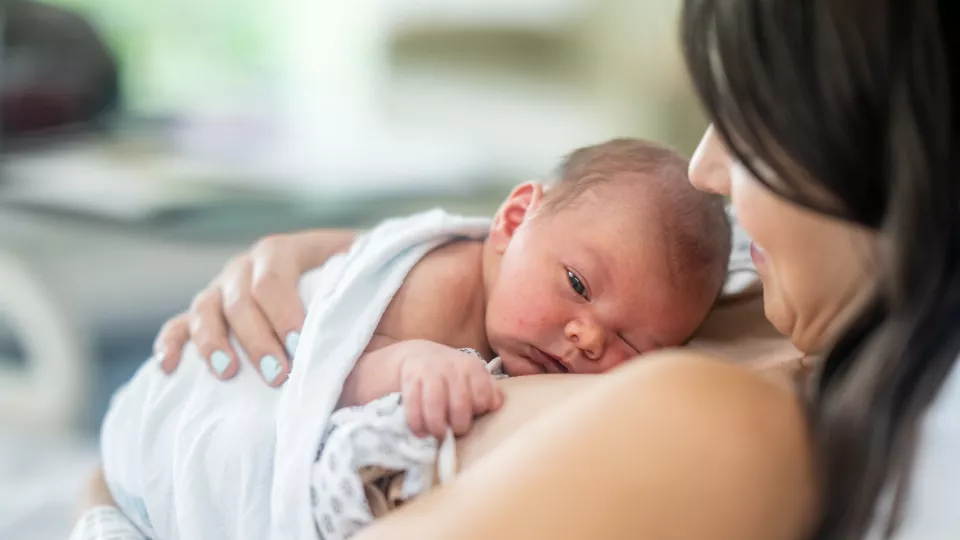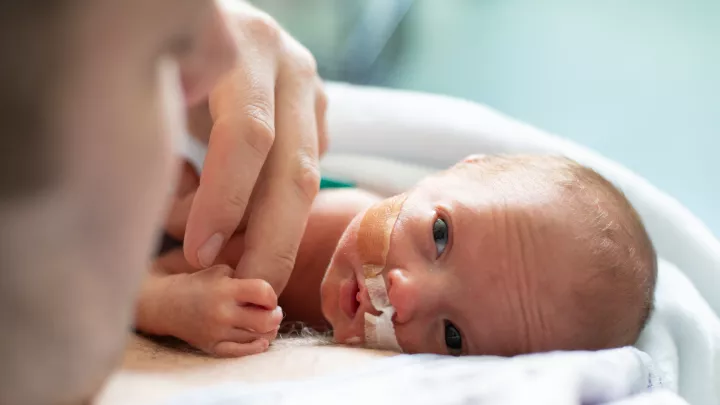
Skin-to-Skin Contact Offers Key Benefits for Parent and Child
Right after a typical birth, Children’s Hospital Los Angeles neonatologist Julie Thai, MD, points out, the first action doctors take is to introduce skin-to-skin contact.
“If the baby is doing OK,” she says, “they are automatically put onto the mom's chest, right?”
The reasons for that, Dr. Thai explains, are more scientific than sentimental. It’s to introduce what will hopefully be the regular practice of skin-to-skin contact between parent and child, which Dr. Thai says has enormous benefits for both—physiological, developmental, clinical, and even psychological.
Skin-to-skin contact is known informally as kangaroo care, named after the practice of mother kangaroos carrying their babies in their pouches, closely held against their bodies. In lieu of pouches, parents are encouraged to hold their naked or diapered baby on their chest.
To overlap with International Kangaroo Care Awareness Day on May 15, CHLA’s Steven & Alexandra Cohen Foundation Newborn and Infant Critical Care Unit (NICCU) and the Thomas and Dorothy Leavey Foundation Cardiothoracic Intensive Care Unit (CTICU) are joining up to host the hospital’s second annual Kangaroo-a-Thon. From May 9-23, the two units will emphasize the practice of skin-to-skin contact between families and their newborns.

“We will encourage as much skin-to-skin contact as possible in our units for the duration of the event,” Dr. Thai says. “All of our parents are going to partake, and our nurses, our respiratory therapists, our physicians, and our APPs [advanced practice practitioners] are all going to be educated or re-educated on the benefits of skin-to-skin.”
Proven benefits of skin-to-skin contact
The positive effects of skin-to-skin contact on babies have been found to be numerous, including better growth, shorter hospital stays, and more stable heart rates, body temperatures, and oxygen levels.
According to Dr. Thai, kangaroo care is practiced throughout the world, with moms carrying their babies wrapped tight against them as they carry out their daily tasks. Notably, in low and middle income countries, it has contributed to decreased rates in neonatal mortality. A recent study indicated that babies who receive skin-to-skin contact have better neurodevelopmental outcomes, and the more of it they get, the even better those outcomes.
“So it’s kind of a dose-dependent response that we're seeing,” Dr. Thai says.
The potential for better neurodevelopmental outcomes is part of what drew Ann Hsieh, MD, Attending Physician in the CTICU, to the Kangaroo-a-Thon, serving as the unit’s physician advocate for skin-to-skin contact.
“I’m interested in research that looks at neurodevelopmental outcomes for our more complex congenital heart disease patients,” Dr. Hsieh says. “This falls in line with some of the other work that I'm trying to do in our unit, bringing more neurodevelopmental support to our babies.”
Both doctors note that the benefits of skin-to-skin contact are felt by parents as well, thanks mainly to the rise in oxytocin levels it creates.

“That's the hormone associated with love and bonding and connecting with others,” Dr. Thai says. “I think that is a big part of why parents feel so much less stressed.”
For moms, she adds that the increased oxytocin also helps promote breast milk supply and breastfeeding. “So there are benefits all around.”
Bringing skin-to-skin contact to the ICU
It’s not easy to enable skin-to-skin contact for sick babies being treated in an intensive care unit, where their illness, the devices they’re attached to, and the web of catheters and IVs running in and out of them, can interfere.
“Ultimately we want our babies to be safe,” Dr. Thai says. “We want them to continue to get the medical therapies we are providing them in the NICCU. But once they're off some of those lifesaving therapies, we try our best to facilitate skin-to-skin, even in our sickest babies.”
It takes some maneuvering to get around all the tubes and machines, but with the help of two or three team members, families are able to enjoy skin-to-skin time with their babies. The units provide big, reclining “kangaroo chairs,” blankets, and wraps so parents can be comfortable and keep the baby secured against their chest.
Dr. Hsieh says that the goal of the Kangaroo-a-Thon is to maximize skin-to-skin contact as much as can be done so that it moves toward becoming the standard of care in the NICCU and the CTICU, and is not reserved exclusively for well babies. She echoes Dr. Thai’s observation about the practice of immediately bringing newborns to mom’s chest moments after birth.
“Not all of our babies have that chance,” Dr. Hsieh says. “Some are really sick and get swept away to some sort of intervention or get intubated or have lines placed. So there’s that missed opportunity for some of these parents.”
Julie Thai, MDWe want to be able to create these really beautiful memories for our families despite their babies having to be in intensive care.
Dr. Hsieh and Dr. Thai both express the hope of allowing all parents to bond with their babies in a way that also delivers plentiful and important health benefits.
“We want to be able to create these really beautiful memories for our families despite their babies having to be in intensive care,” Dr. Thai says.
“I love promoting skin-to-skin because it allows our families to participate in their infant’s healing journey. They are literally providing the medicine that has been shown to improve their growth and outcomes later in life.”


